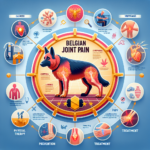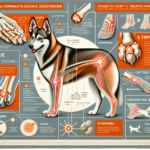Silky Terrier Joint Pain: Causes, Symptoms, Prevention, and Treatment

Introduction
The Silky Terrier, often affectionately known as the “Silky,” is a small, energetic breed that originated in Australia. Known for their silky, blue-and-tan coats, these dogs are a blend of the Australian Terrier and the Yorkshire Terrier. Silky Terriers are characterized by their lively personalities, intelligence, and loyalty, making them excellent companions for families and individuals alike.
While Silky Terriers are generally healthy dogs, they are not immune to certain health issues. Common concerns include dental problems, patellar luxation, and, notably, joint pain. Joint health is particularly crucial for this breed due to their active nature and small size, which can make them more susceptible to joint-related issues.
Breed-Specific Joint Pain Risks
Genetic Predisposition
Silky Terriers, like many small breeds, are genetically predisposed to certain joint issues. One of the most common is patellar luxation, a condition where the kneecap dislocates from its normal position. This can lead to pain, lameness, and eventually arthritis if not treated. While hip dysplasia is more common in larger breeds, it can still occur in Silkies, leading to similar long-term joint issues.
Age-Related Risks
As Silky Terriers age, the risk of developing joint pain increases. Arthritis is a common age-related condition that affects many older dogs, including Silkies. Typically, signs of arthritis may start to appear around the age of 7 or 8, but this can vary depending on the individual dog’s health and lifestyle.
Activity Level and Joint Stress
Silky Terriers are known for their high energy levels and love for play. While regular exercise is essential for their overall health, excessive or inappropriate activities can put undue stress on their joints. Jumping from heights, running on hard surfaces, or engaging in high-impact activities can exacerbate joint issues, especially if the dog already has a predisposition to such problems.
Common Symptoms of Joint Pain in Silky Terriers
General Symptoms
- Limping or favoring one leg
- Stiffness, especially after resting
- Reluctance to jump, run, or climb stairs
- Decreased activity or playfulness
- Visible discomfort or pain when touched
- Swelling around the joints
Breed-Specific Symptoms
In Silky Terriers, symptoms of joint pain may also include a noticeable “bunny hop” gait, where the dog uses both hind legs together when running. Additionally, due to their small size, even slight changes in their movement or behavior can be more noticeable compared to larger breeds.
When to Consult a Vet
If you observe any of the above symptoms in your Silky Terrier, it is crucial to consult a veterinarian promptly. Early diagnosis and treatment can significantly improve the quality of life for your dog and prevent further joint deterioration.
Preventive Measures for Joint Health
Exercise Recommendations
Regular, moderate exercise is key to maintaining joint health in Silky Terriers. Activities such as short walks, gentle play sessions, and swimming are excellent options. Avoid high-impact exercises like jumping or running on hard surfaces, as these can exacerbate joint issues.
Dietary Suggestions
A balanced diet rich in essential nutrients can support joint health. Look for dog foods that contain glucosamine and chondroitin, which help maintain cartilage health. Omega-3 fatty acids, found in fish oil supplements, can also reduce inflammation and support joint function.
Weight Management
Maintaining a healthy weight is crucial for reducing stress on your Silky Terrier’s joints. Obesity can exacerbate joint pain and lead to other health issues. Follow your veterinarian’s guidelines for portion sizes and avoid overfeeding or giving too many treats.
Early Screening and Monitoring
Regular veterinary check-ups are essential for early detection of joint issues. Your vet may recommend specific screening tests, such as X-rays or joint fluid analysis, to monitor your dog’s joint health. Early intervention can make a significant difference in managing joint pain effectively.
Treatment Options for Joint Pain
Non-Surgical Treatments
Non-surgical treatments for joint pain in Silky Terriers include:
- Medications: Anti-inflammatory drugs and pain relievers can help manage pain and reduce inflammation.
- Physical Therapy: Exercises and stretches designed to improve joint mobility and strengthen surrounding muscles.
- Lifestyle Adjustments: Modifying activities to reduce joint stress and incorporating low-impact exercises.
Surgical Options
In severe cases, surgical intervention may be necessary. Common surgical options include:
- Patellar Luxation Surgery: Realigning the kneecap to its proper position.
- Hip Dysplasia Surgery: Procedures such as femoral head ostectomy (FHO) or total hip replacement (THR) to alleviate pain and improve function.
- Arthroscopy: A minimally invasive procedure to clean out the joint and remove damaged tissue.
Alternative Therapies
Alternative treatments can also be beneficial for managing joint pain in Silky Terriers:
- Acupuncture: Can help reduce pain and improve joint function.
- Hydrotherapy: Water-based exercises that reduce joint stress while improving mobility.
- Massage: Helps relieve muscle tension and improve circulation around the joints.
Lifestyle and Management Tips
Daily Care Routine
A sample daily care routine for a Silky Terrier with joint pain might include:
- Morning: Gentle walk on a soft surface, followed by a joint supplement with breakfast.
- Midday: Short play session with low-impact toys.
- Afternoon: Another gentle walk or swim session.
- Evening: Massage or physical therapy exercises, followed by a balanced dinner.
Modifying the Home Environment
Making your home more comfortable for a dog with joint pain can significantly improve their quality of life. Consider the following modifications:
- Install ramps or steps to help your dog access furniture or climb stairs.
- Provide orthopedic beds that offer better support for their joints.
- Ensure food and water bowls are at a comfortable height to reduce strain.
Long-Term Management
Long-term management of joint pain involves a combination of regular veterinary care, appropriate exercise, a balanced diet, and weight management. Consistency is key to keeping your Silky Terrier active and happy despite joint pain.
FAQs About Silky Terriers and Joint Pain
What are the early signs of joint pain in Silky Terriers?
Early signs include limping, stiffness, reluctance to move, and decreased activity levels. If you notice any of these symptoms, consult your veterinarian promptly.
Can joint pain in Silky Terriers be prevented?
While genetic predispositions cannot be entirely prevented, maintaining a healthy weight, providing appropriate exercise, and regular veterinary check-ups can significantly reduce the risk of joint pain.
Are there specific foods that can help with joint health?
Yes, foods rich in glucosamine, chondroitin, and omega-3 fatty acids can support joint health. Consult your veterinarian for specific dietary recommendations.
Is surgery always necessary for joint pain in Silky Terriers?
No, surgery is typically considered a last resort. Many cases of joint pain can be managed with non-surgical treatments such as medications, physical therapy, and lifestyle adjustments.
Conclusion
Joint pain is a common issue that can significantly impact the quality of life for Silky Terriers. By understanding the causes, symptoms, and preventive measures, owners can take proactive steps to ensure their dog’s joint health. Regular veterinary check-ups, appropriate exercise, a balanced diet, and weight management are crucial components of joint care. If joint pain does occur, a range of treatment options, both surgical and non-surgical, are available to help manage the condition. By staying informed and vigilant, you can help your Silky Terrier live a happy, active life despite joint pain.
Remember, early intervention is key. If you notice any signs of joint pain in your Silky Terrier, consult your veterinarian promptly to develop an effective treatment plan.




